Home » Posts tagged 'research' (Page 2)
Tag Archives: research
Nathan Lents is sticking to the science
As an evolutionary biologist, and author of such books as Not So Different: Finding Human Nature in Animals and Human Errors: A Panorama of Our Glitches, From Pointless Bones to Broken Genes, Nathan H. Lents has joined the ranks of scientists whose work is under attack by proponents of intelligent design.
There is no coherent theory about intelligent design; according to Lents, the one commonality is that supporters “don’t buy modern evolutionary theory, or some part of modern evolutionary theory. They hold a whole variety of incompatible positions.” The views of intelligent design supporters range from believing the planet was created less than 10,000 years ago, to finding a role for God in gradual or ongoing acts of creation and evolution, to those who think God “set up” for life to evolve as it has in something Lents calls “the Perfect Pool Shot.”
Lents’s most recent book, Human Errors, came out in 2018 to great excitement from the science and reading communities. When it was published, he thought that intelligent design supporters “would just roll their eyes. I didn’t offer it as a serious critique [of intelligent design], so I didn’t think they would respond in a serious way but they absolutely did; they went on the attack.” Lents said it took him months to learn about the different types of creationists and how to respond to and refute their attacks effectively, promoting scientific thought without getting dragged into the mud.
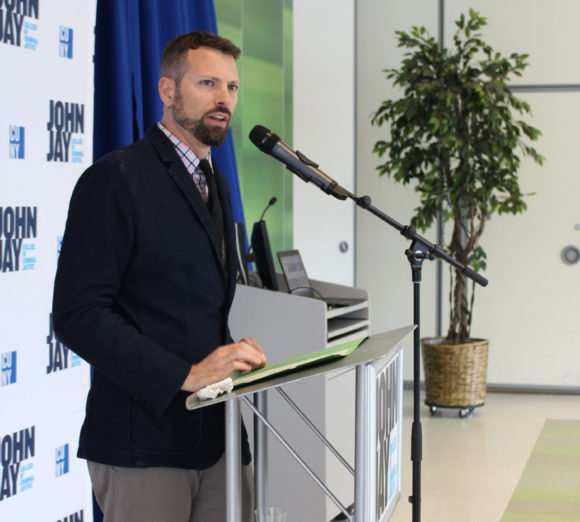
This month, Lents and two co-authors can be found standing up for modern evolutionary theory in Science, a journal that has been at the center of important scientific discovery and thought since its founding in 1880, reviewing Darwin Devolves, a new book by biochemist Michael Behe. He is among the best-known figures in the intelligent design movement; Lents characterizes Behe as a serious man who views his own work as serious science.
“Michael Behe believes in common descent, the true age of the earth, that all living things have evolved, he believes in all of that. But the only thing that he takes issue with is the source of all this diversity in life, that then gets acted on by natural selection. He thinks that God or a supernatural force of some kind has to provide this new influx of genetic information somehow, periodically, and then evolution can play out for a while. Either it was preloaded in the ‘perfect pool shot’ or there are ‘continuing miracles of life.'”
While creationism and trying to explain science with a creationist mindset have always been with us, in the late 1990s Behe introduced a concept called “irreducible complexity,” and this notion has really taken over those who are trying to marry science and creationism. Irreducible complexity is the idea that evolution must be false because natural selection acts by propagating mutations that create advantage for the organism; however, some structures are so complex that they never could have evolved, because their individual pieces must work together to convey advantage. Behe holds that evolution could not have produced all of the interrelated structures in a complex system like, for example, the eye, because the innumerable steps and parts it takes to make up the eye (and therefore to create vision) aren’t advantageous on their own, and therefore could not have evolved without the hand of an intelligent designer.
Lents doesn’t agree with that theory. “What we do know is that these structures don’t evolve as fully-formed units. When the eye was evolving, it wasn’t like a fully-formed retina — boom — just appeared, and then a full-formed lens, that’s not how it works. The whole thing becomes gradually more complex, and then, of course, many, many steps later it looks like if you remove any one part the whole thing doesn’t work, but that’s because it’s evolving as a unit, not stepwise. It’s not like building a car. The good thing is that, if you look at the eye, we can find intermediates, not in the fossil record but in living things right now, that have an earlier version of the eye.”
In this review, Lents sticks to the science. They point to sections or examples in Darwin Devolves that fail to take into account evidence produced by testing modern evolutionary theory. Although Lents and both of his co-authors have been subject to attacks on their work by supporters of creationism, he says he’s learned his lesson about responding to attacks that are ultimately unserious or political in nature.
“I’ve come to realize, Lents says, “that in these exchanges, my real audience is not the intelligent design community. I’m writing for millions of silent readers who come into this debate innocently and earnestly when they see their children start to learn about evolution in middle school and they want to see what’s out there, they want to read for themselves. So that’s who I’m writing for, the people who are just genuinely trying to find answers about what the science really says, what evidence do we really have, that kind of stuff. So I’m not really speaking to the intelligent design community anymore, I’m just speaking to the general public, trying to correct the record on science.”
In fact, that really sums up Lents’s approach to writing more generally. He wrote his second book for the general public, “first of all to entertain, but also to help them understand how these little quirks that we have in our bodies have come to be, and how to live with them, and survive and thrive.” It’s very important to Lents to advance the idea of a scientific mindset, which he says intelligent design proponents don’t have.
“Science, at its best, comes at the evidence and tries to come up with an explanation that best fits that evidence. And even when that explanation starts to become what we call accepted science, it is still tested. But intelligent design supporters, including Michael Behe, their starting point is that they have a truth that they already believe is true, and then they try to mold an explanation for the science around that preconceived notion. So it’s backwards. And that’s why they end up with egg on their face so often, because they’ll come up with an explanation that fits the limited data that we have at one point in time, and then we just get more data and a fuller understanding and they have to keep revising their explanation. And that’s just not a good way to come up with the truth.”
Lents plans to continue writing fact-based science texts with the general public in mind, even if he does invite further criticisms from the intelligent design community or other conservative elements. He says he’s currently laying the foundation for his next book, “which is about human sexuality in the evolutionary context. If you see a pattern in my work, it’s that I’m getting more and more controversial with each book.” Lents wants to look at human sexuality as it’s connected to the greater natural world, and the ways that social constructs have shaped our expressions of sexuality. His argument? “A label-free approach to sexuality is much more in line with our natural biology. The only thing labels do is create restrictions.”
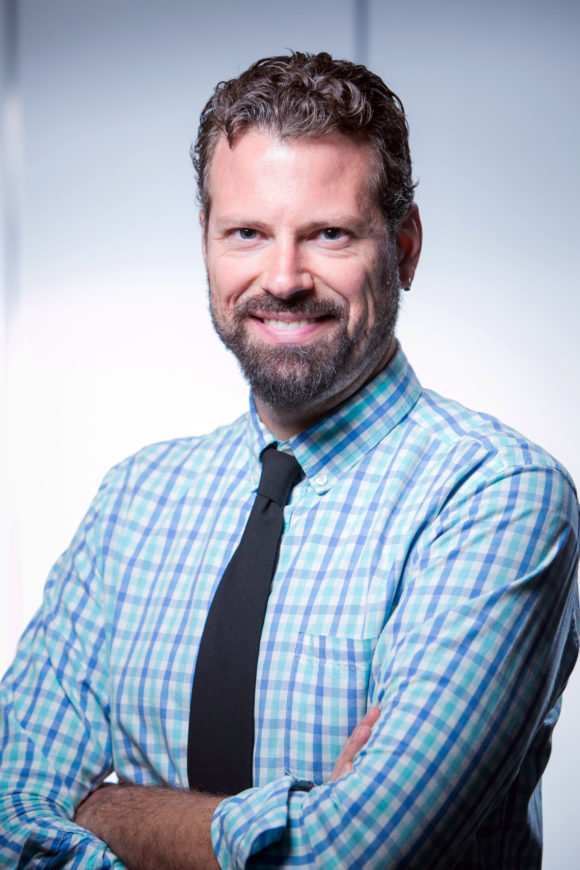
Dr. Nathan H. Lents is a Professor of Biology at John Jay College, as well as the Director of John Jay’s Honors College. Apart from being the author of the two books mentioned above, Dr. Lents blogs at The Human Evolution Blog and on Psychology Today. For more, read his bio.
To read his review with co-authors Joshua Swamidass and Richard Lenski in Science, visit the website.
John Jay Scholars on the News – Vaccines and the Flu

It’s winter, which we sometimes call “flu season.” In fact, “you can catch influenza at any time during the year if exposed to the virus, and its severity is the same regardless of when you get sick,” says Edgardo Sanabria-Valentín. We don’t fully know the answer to why influenza is more common during the colder months. According to Nathan Lents, “The virus is viable for a longer time in cold air, and spreads more readily in dry air. Another reason that may contribute is that winter air dries our mucus membranes, which makes them less effective at preventing viral entry. We also tend to spend more time indoors with closed windows and recirculated air.”
A somber anniversary
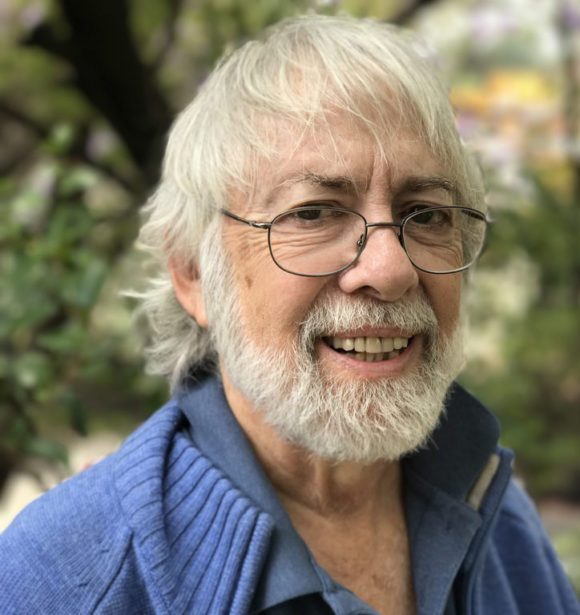
The 2018 flu season was also the 100th anniversary of the infamous global influenza pandemic, a year when more
than 500 million people around the world are estimated to have died from flu. Of that number, 675,000 fatalities came from the United States, with roughly 20,000 from New York City alone. According to Mike Wallace, in his 2018 book Greater Gotham, more Gothamites died of disease in the city than died during World War I; the ongoing war effort actually impaired New York’s efforts to fight the flu, by concentrating soldiers in training camps where disease could spread and by taking much-needed medical personnel away from home to establish medical camps near the battlefields in Europe.
Despite the high numbers of fatalities at home, New York of 1918 had a lower death rate than other major cities (4.7 deaths per 1,000 residents, as compared to Boston’s rate of 6.5 and Philadelphia’s of 7.3). This was attributed by Health Commissioner Royal Copeland to New York’s long history of public health work, and particularly the alleviation of unhealthy conditions around the city at the turn of the 20th century.
Vaccines and you

Today, scientific and public health efforts have brought some protection from a repeat of 1918 in the form of vaccines. In the case of the flu, explains Dr. Lents, “Each year’s vaccine is targeted toward the three to four strains that appear to be spreading the most rapidly. The injected vaccine contains killed viruses [from those strains], while the nasal spray contains live but weakened viruses. In both cases, the large dose of viral particles elicits a strong immune reaction from our bodies, including the production of antibodies that can stick around for years or even decades. The second time we are exposed to the same virus, it only takes a day or two to mount the same level of immune response. This ‘priming’ gives the immune system enough of a head start that it usually prevents the infection from ever taking hold.”
Because the influenza virus is so good at mutating from year to year, “no vaccine is 100% perfect, and getting the flu shot will never protect you against 100% of all flu strains,” says Dr. Sanabria-Valentín. But the vaccine will “significantly decrease the risk of getting sick, and will decrease the severity and length of infection, and decrease the chance that you get other people sick” if you do contract the virus.
Vaccinating also helps to protect those around you in other ways, namely by contributing to “herd immunity.” “Some people cannot be vaccinated because they are too young, too old, immune-compromised, or battling other kinds of infections,” says Dr. Lents. When the percentage of people in a population are effectively immunized, it helps to prevent the spread of disease to those who were unable to receive the vaccine. But when the percentage of vaccinated people falls because individuals who otherwise could be immunized choose not to be, it puts vulnerable populations at risk.
Conquering vaccine hesitancy
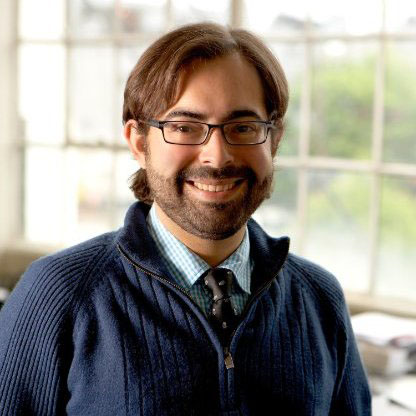
“Controversies about vaccinations have been out there since we adopted this preventative measure almost 100 years ago,” says Dr. Sanabria-Valentín. “There are a lot of myths about vaccinations which are peddled by conspiracy theorists trying to sell you something or by people who might have good intentions but got swindled by ill-intentioned people trying to make a fast buck. One of the most popular ones is that vaccines can cause autism in children. This claim was first made in a study that was demonstrated (by many groups) to be fraudulent; no direct relationship between receiving vaccinations and autism has been found. There is overwhelming consensus among scientists and physicians that vaccines are safe and effective even though, like most medical treatments, in very rare cases they can cause side effects and in even rarer instances can cause serious unintended health problems. There is overwhelming evidence that vaccination has helped not just individuals, but humankind.” Although diseases like smallpox, polio and the measles were all but eliminated by vaccine technology, skepticism about immunization–which many attribute to the rise of social media–has caused some long-gone diseases to stage a comeback.
Dr. Lents stated that “in 2017, 80,000 people died of influenza, the highest number in 40 years. If more healthy people had been vaccinated, that number could have been much less. Each person that decides not to vaccinate adds a little bit of risk to the entire population.” This dynamic played out in October 2018, when measles–which was declared eliminated in the US in 2000–broke out in Williamsburg, Brooklyn. The New York City Department of Health confirmed 42 cases in Williamsburg and Bensonhurst as of mid-December, and is currently barring un-immunized students from attending local schools. And according to The Guardian, Europe is also experiencing a surge in vaccine hesitancy and a corresponding growth in the numbers of new measles cases; Europe will see more than 60,000 new cases this year and 72 deaths, the highest number this century.
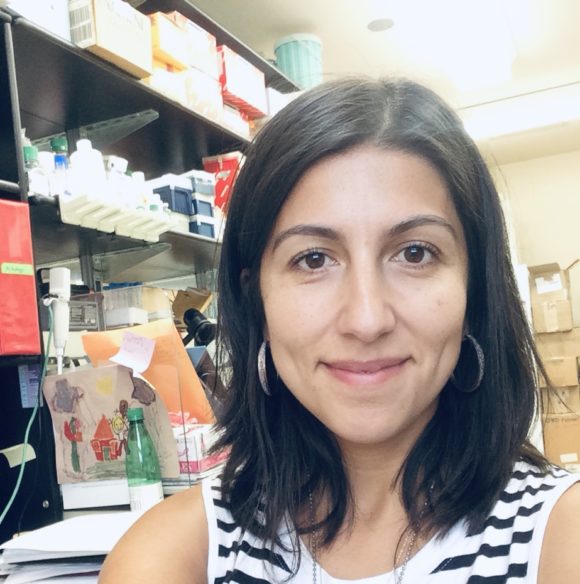
It is generally agreed that fears about vaccine side-effects are overblown, and contradicted by scientific consensus. “Vaccines are constantly monitored and modified as circumstances dictate. The FDA does not approve a vaccine unless initial trials indicate the benefits clearly outweigh the risks. In response to vaccine safety concerns today, healthcare providers have to give vaccine information sheets to recipients clearly describing the risks and benefits of the vaccine. And finally, vaccines are subject to particularly high safety standards because, unlike other health treatments, they are given as preventive measures to protect healthy people,” explains Dr. Evelyn Aranda Jaque. “Although vaccination is not 100% effective, studies on flu vaccination programs have shown that people who get vaccinated are less likely to be seriously ill or die in comparison with those who do not vaccinate. We must consider that the widespread use of vaccines for life-threatening diseases in the United States has led to a dramatic decrease in their incidence.”
Evelyn Aranda Jaque is a substitute Associate Professor at John Jay College, where she teaches classes including Immunology and Microbiology. She received her Ph.D. from the Physiology Department at Pontificia Universidad Católica de Chile. Dr. Aranda Jaque’s research since her doctorate days has largely focused on the role of angiogenesis (the formation of new blood vessels) in tumor progression.
Nathan Lents is a Professor of Biology and Director of the Honors Program and Macaulay Honors College at John Jay College. He holds a Ph.D. in human physiology and postdoctoral training in computational biology from NYU. In addition to his laboratory research, Dr. Lents writes popular science articles, blog and books. His most recent book is Human Errors: A Panorama of Our Glitches from Pointless Bones to Broken Genes.
Edgardo Sanabria-Valentín is the Associate Program Director of John Jay College’s Program for Research Initiatives in Science and Math (PRISM) as well as the college’s Pre-Health Careers Advisor. He holds a Ph.D. from NYU-School of Medicine, and spent three years working in the biotechnology industry. Dr. Sanabria-Valentín is the recipient of the ESCMID Young Scientist Award (2007), a Leadership-Alliance Schering Plough Graduate Fellowship (2006), and the NBHS-Frank G. Brooks Award for Excellence in Student Research (2001).
Mike Wallace is a Distinguished Professor of History at John Jay College and author of Greater Gotham: A History of New York City from 1898 to 1919. Dr. Wallace is also the co-author of Pulitzer Prize-winning Gotham: A History of New York City to 1898 and the founder of the Gotham Center for New York City History at the CUNY Graduate School. He received his undergraduate and graduate degrees from Columbia University.
Fostering Success in STEM – Dr. Edgardo Sanabria-Valentín
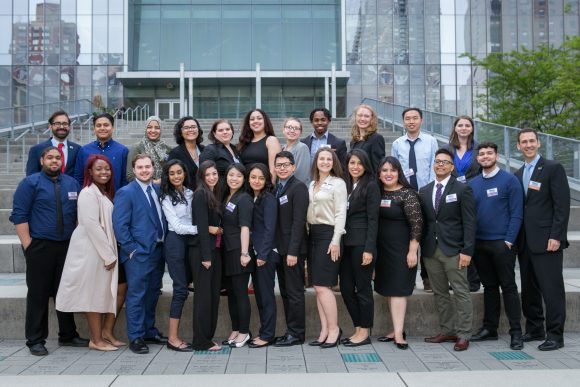 Dr. Edgardo Sanabria-Valentín sees himself in the PRISM students he works with. He credits his alma mater, the University of Puerto Rico, with instilling in him the spirit of preparedness that he brings to student researchers and presenters at John Jay — being ready not only with the technical facts but with the message about why your research is important, and how you are changing the world.
Dr. Edgardo Sanabria-Valentín sees himself in the PRISM students he works with. He credits his alma mater, the University of Puerto Rico, with instilling in him the spirit of preparedness that he brings to student researchers and presenters at John Jay — being ready not only with the technical facts but with the message about why your research is important, and how you are changing the world.
“Because of that, every time we go to a conference, we get minimum one award — my top is three!” he says. “Every time we go to an undergraduate research conference, John Jay’s name always comes up.” It is this tangible commitment to bringing out the best in John Jay’s science students that earned Dr. Sanabria-Valentín, who is the Associate Director of the John Jay Program for Research Initiatives in Science and Math (PRISM), a 2018 APACS President’s Award.

At its heart, PRISM is about teaching students skills, not only in the sciences but also to prepare them to succeed in and after college. “The bread and butter upon which PRISM was founded” is the Undergraduate Research Program. The program provides students with opportunities to be exposed to the process of science beyond their normal classroom studies by working directly with a faculty mentor on an original STEM research project.
And PRISM has grown. A second component is the Junior Scholars program, giving academic support to eligible students that can include stipends, professional development events and supplementary advisement, as well as financial support in applying to post-graduate programs in New York State-licensed professions. Just as important for an institution that counts many first-generation college students among its student body, Junior Scholars collaborates with student support services across the college, like the Math and Sciences Research Center, Center for Career and Professional Development, Wellness Center, Center for Postgraduate Opportunities, and even more. The program is designed to make sure that students have all the tools to get to know their college and excel.
External funding is part of what drives PRISM’s growth. The New York State Collegiate Science and Technology Entry Program, or CSTEP, awards grants to postsecondary and professional schools to start academic support programs — like PRISM — for students from underrepresented minority groups, or who are economically disadvantaged, to help them get into STEM fields. John Jay was among the first class of schools to receive CSTEP funding, thirty years ago and out of roughly 200 PRISM students, the CSTEP grant supports 140. Edgardo’s goal is to double that number over the next five years.
His hard work is a large part of why the CSTEP program is at John Jay — after a short hiatus, Edgardo’s application brought the program back in 2015 — and of John Jay’s unique status as the only school to have institutionalized this type of academic STEM-focused support initiative. He is also responsible for collaborating with other CSTEP schools in the region: NYU, Hostos Community College, Fordham, City College and Mt. Sinai are among the Manhattan and Bronx institutions that participate with John Jay in our CSTEP Regional Research Expos. Participating students are invited to present their own research in poster sessions and attend professional development activities.
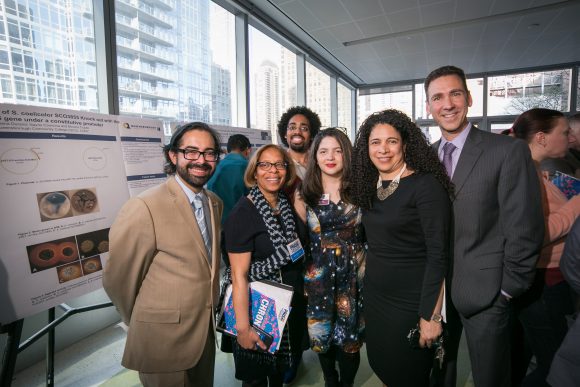
His work on and logistical support for the expos has earned Edgardo an award from the President of the Association of Program Administrators for CSTEP and STEP (APACS). The honor also recognizes his success in running a program that benefits students in the sciences. The advisement services offered by PRISM have created the conditions for increased student success at John Jay and degree completion, and the program puts students on a path toward the pursuit of higher degrees, or toward a place in the workforce in a variety of science, technology and computer science fields. The Undergraduate Research Program has measurably helped students to pursue post-graduate degrees in science, medicine and more.
The bottom line for Edgardo, though, is his students. “My kids blow me away every time,” he gushes. “I have complete pride in showing them off at every conference I go to. I have learned so much by helping them with posters and advising on their projects; it’s encouraging that I sometimes find my students to be smarter than me.”
Learn more about:
PRISM: http://prismatjjay.org/
APACS: http://www.apacs.org/
CSTEP in New York State: http://www.highered.nysed.gov/kiap/colldev/CollegiateScienceandTechnologyEntryProgram.htm
 Edgardo Sanabria-Valentín, Ph.D. is the Associate Program Director for PRISM and also the Pre-Health Careers Advisor at John Jay. He holds a Ph.D. from NYU-School of Medicine, where his dissertation work involved studying the mechanisms Helicobacter pylori employs to persist in the human stomach for the life span of each host. He came to John Jay after a Post-Doctoral Fellowship at Harvard Medical School followed by 3 years working in the Biotechnology Industry in Boston. Dr. Sanabria-Valentín is the recipient of the ESCMID Young Scientist Award (2007), a Leadership Alliance-Schering Plough Graduate Fellowship (2006), and the NBHS-Frank G. Brooks Award for Excellence in Student Research (2001). He is also a founding member of the NYC-Minority Graduate Student Network and The Leadership Alliance Alumni Association.
Edgardo Sanabria-Valentín, Ph.D. is the Associate Program Director for PRISM and also the Pre-Health Careers Advisor at John Jay. He holds a Ph.D. from NYU-School of Medicine, where his dissertation work involved studying the mechanisms Helicobacter pylori employs to persist in the human stomach for the life span of each host. He came to John Jay after a Post-Doctoral Fellowship at Harvard Medical School followed by 3 years working in the Biotechnology Industry in Boston. Dr. Sanabria-Valentín is the recipient of the ESCMID Young Scientist Award (2007), a Leadership Alliance-Schering Plough Graduate Fellowship (2006), and the NBHS-Frank G. Brooks Award for Excellence in Student Research (2001). He is also a founding member of the NYC-Minority Graduate Student Network and The Leadership Alliance Alumni Association.



Recent Comments